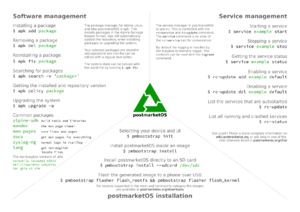Terminal cheat sheet

Here's a small reference for working with postmarketOS/Alpine Linux.
Package management
The package manager in postmarketOS is called apk, the Alpine Package Keeper. The list of packages can be found at pkgs.alpinelinux.org and pkgs.postmarketos.org.
Installing a package
$ sudo apk add -i neovim
Uninstalling a package
$ sudo apk del -i neovim
Upgrading the system. The -a option allows downgrading packages to what's available in the repository. It is generally recommended to always use this option, especially on stable releases, to ensure that any package reverts make it to your device.
$ sudo apk upgrade -a -i
Run various package repair strategies, e.g. running failed installation scripts again:
$ sudo apk fix
$ sudo apk fix name-of-package # will also reinstall name-of-package
Listing installed package versions (add | grep package-name to filter for a specific package):
$ apk info -vv
Installing build dependencies:
$ sudo apk add -i build-base install-makedepends
$ install-makedepends neovim
The repositories are stored in /etc/apk/repositories as one repository url per line. There's also /etc/apk/world which is a list of packages that are explicitly installed. It's possible to add/remove packages from this list and then running apk fix to apply those changes. The Alpine Linux wiki has a page comparing apk to other popular distros, with many helpful examples.
New installations of postmarketOS let apk ask for confirmation by default. If you don't want this, delete /etc/apk/interactive (pmaports!3444).
Service management
The service manager in postmarketOS is OpenRC. The basic service management is done with the familiar rc-service command.
Tip: rc-service is also symlinked to service which is shorter to type. |
$ rc-service networkmanager status
$ sudo rc-service networkmanager start
$ sudo rc-service networkmanager stop
$ sudo rc-service networkmanager restart
To enable or disable services on boot you use the rc-update command.
List the services that are added to a runlevel
$ rc-update
bootmisc | boot
chronyd | default
dbus | default
devfs | sysinit
dmesg | sysinit
gdm | default
haveged | default
hostname | boot
hwclock | boot
killprocs | shutdown
Start NetworkManager on boot (in the default runlevel)
$ sudo rc-update add networkmanager default
Stop NetworkManager starting on boot
$ sudo rc-update del networkmanager default
Log files
By default postmarketOS uses the busybox logging daemon for the syslog and it's configured to log to memory only. The logread command is used to read the in-memory log. Writing standard output and standard error of a system service to the filesystem can be achieved by setting output_log and error_log to file paths in its service script, as described in the manual page openrc-run.
ModemManager logs to syslog by default as well, but prints almost nothing until manually increasing the log level with sudo mmcli -G DEBUG. Be aware that especially ModemManager logs a lot of sensitive information, such as phone numbers, text messages, IMEI, cell towers, etc!
Most user interfaces use tinydm to start the session in postmarketOS, which logs to ~/.local/state/tinydm.log.
A discussion to possibly change logging defaults is in pmaports#1574.
Man pages
Man pages are not installed by default and are seperate from the normal packages. The docs package is a metapackage that will pull in all the documentation for the software you have installed. You can also install only the documentation you need by not installing the docs package
but installing the specific documentation subpackage. For example for vim documentation you can install vim-doc
the mandoc package is the man page reader itself
the man-apropos adds the apropos manpage search tool
the man-pages package will add the pages for core software like chmod but also linux headers
the docs package is a metapackage that pulls in the -doc package for everything you install
$ sudo apk add -i mandoc mandoc-apropos man-pages docs
$ man nvim
Changing your shell
Since the pmos installations are based on busybox the default shell is ash, which is comparible to sh. There are multiple shells packaged in Alpine if you want something better:
pick your favorite shell
$ sudo apk add -i bash zsh fish dash yash oksh elvish
set your login shell
$ chsh -s /bin/zsh
some config distributions are packaged
$ sudo apk add -i grml-zsh-config oh-my-zsh
See also
- pmaports#1574 Make logging consistent